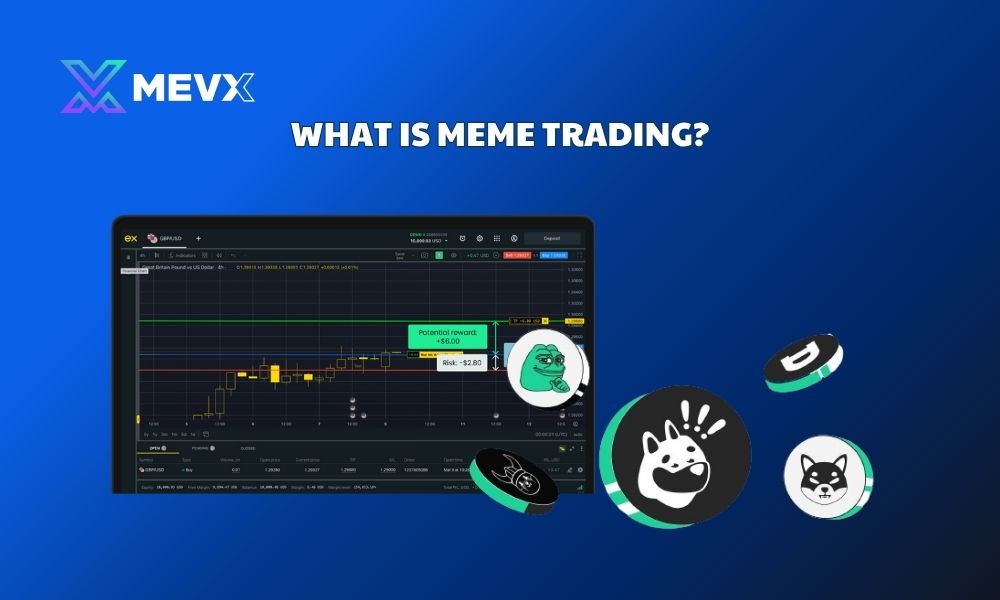What is meme trading is a question on many minds after witnessing the explosion of assets like Dogecoin or GameStop stock. This is a form of trading based on the virality of memes, social media hype, and community power, rather than on fundamental financial analysis. It’s a modern phenomenon driven by collective digital belief.
What is meme trading?
So, what is meme trading? In essence, it is a term used to describe the act of buying and selling assets (primarily stocks and cryptocurrencies) whose prices skyrocket not because of the company’s financial health or potential, but because of massive attention and hype on social media platforms like Reddit, Twitter (now X), or TikTok.
Unlike traditional investors who rely on fundamental analysis (revenue, profit, P/E ratio) or technical analysis (charts, price trends), meme traders often make decisions based on different factors:
- Meme virality: An image, a joke, or a funny video related to a stock or coin can become the catalyst for a price surge.
- Community power: Online communities, such as the r/wallstreetbets forum on Reddit, can coordinate to buy an asset together, creating immense buying pressure that drives the price up.
- The FOMO effect (Fear of Missing Out): When retail investors see an asset’s price increase astronomically, they rush to buy in, fearing they will miss out on a quick profit opportunity, which further fuels the price rally.
The nature of what is meme trading is speculation based on crowd psychology and media hype.

The origin and explosion of meme trading
The meme trading trend truly exploded onto the global stage in early 2021 with the GameStop (GME) saga. At that time, large Wall Street hedge funds were shorting GME stock, betting that the video game retail company would fail.
However, a community of retail investors on a Reddit forum noticed this and called on each other to buy GME stock. They bought not just because they believed in the company’s potential, but also because they wanted to “fight back” against the large investment funds. This collective action created a historic “short squeeze,” causing GME’s stock price to surge over 1,700% and inflicting billions of dollars in losses on hedge funds. The GameStop event is the classic answer to the question of what is meme trading and how it operates.
In the cryptocurrency market, Dogecoin is the most prominent example. Initially created as a joke, Dogecoin suddenly became globally famous thanks to endorsements from influential figures like Elon Musk. His tweets have repeatedly caused the price of Dogecoin to soar, attracting a massive number of meme traders.
Key characteristics of meme trading
To better understand what is meme trading, we need to identify its core characteristics:
Extreme volatility: The prices of “meme stocks” and “meme coins” can rise or fall by tens or even hundreds of percent in a single day. This is a double-edged sword, offering the chance for huge profits but also carrying the risk of total loss.
Dependence on social media: The value of these assets is directly tied to the level of discussion online. When the hype dies down, the price can collapse just as quickly.
Lack of intrinsic value: Most meme assets do not have a solid business foundation or breakthrough technology. Their value comes primarily from the community’s belief and speculation.
Community and “anti-establishment” sentiment: Many people participate in meme trading with a sense of solidarity, viewing it as a battle of the small retail investor against large financial institutions.
Risks and opportunities in meme trading
Once you understand what is meme trading, you need to carefully weigh the opportunities against the risks before deciding to participate.
Opportunities:
- Explosive profits: This is the biggest draw. If you are lucky and time your entry and exit correctly, you can make enormous profits in a short period.
- Easy access: Anyone with a trading account and a small amount of capital can participate.
Risks:
- Bubble risk: Price surges based on hype are often unsustainable. When the bubble bursts, those who bought in late will suffer heavy losses.
- Market manipulation: “Whales” or influential figures can exploit the community to execute “pump and dump” schemes, driving the price up to sell for a profit and leaving retail investors holding the bag at the top.
- Emotional decision-making: The pressure from FOMO and FUD (Fear, Uncertainty, and Doubt) can lead you to make rash, ill-considered buying and selling decisions.
Advice for new investors
So, should you try meme trading? The answer depends entirely on your risk appetite and financial goals. If you decide to participate, treat it more like a high-stakes game than a serious investment strategy.
- Only invest what you are willing to lose: This is the golden rule. Never use your savings, borrowed money, or essential funds for meme trading.
- Do your research: Even though it’s community-driven, you should still research the asset and the general market sentiment yourself.
- Set take-profit and stop-loss points: Don’t get too greedy. Decide in advance the profit level you are aiming for and the loss you can tolerate.
The essence of what is meme trading is a highly volatile and emotional game. It can bring unimaginable profits, but it can also wipe out your entire capital in the blink of an eye.
In summary, meme trading is a high-risk speculative trend driven by social media and crowd psychology. It is not for the faint of heart or for investors seeking stability.
